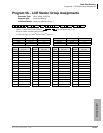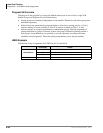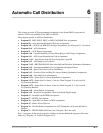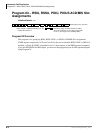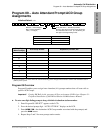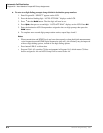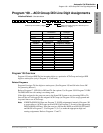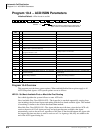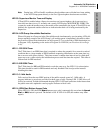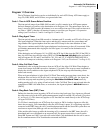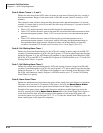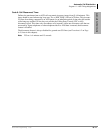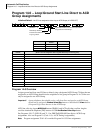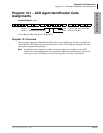
Automatic Call Distribution
Program 10-4 – ACD/ISDN Parameters
Strata DK Programming 5/99 6-7
Automatic Call Distribution
Note During busy ACD call traffic conditions, the algorithm routes calls that have been waiting
in the ACD Group queue directly to the first Agent telephone that becomes available.
LED 03: Supervisor Monitor Tone and Display
If Tone/LCD is enabled when a Supervisor monitors an Agent telephone, the Agent receives a
short dial tone burst (every 15 seconds) and a steady LCD display: MONITOR BY SUPRV. The
system also sends the monitor tone to the outside caller connected to the Agent. If Tone/LCD is not
enabled, the Agent and outside caller has no indication that their call is being monitored by the
Supervisor.
LED 04: ACD Group Unavailable Destination
When all Agents in a Group are in the Unavailable mode simultaneously, new incoming ACD calls
that are normally routed to the ACD Group’s call waiting queue is immediately diverted to either
the Overflow-Queue-Point destination (set in Program 14-5) or to the End-of-Shift destination (set
in Program 14-6), depending on the status of Program 10-4 LED 04 (see Flowchart 6-6 on Page
6-46).
LED 11: PRI ISDN Timer
The T-Wait timer is an ISDN timer that is required to reduce the potential for a network overload
condition due to a large number of ISDN terminals requesting initialization at the same time (e.g.,
due to an area-wide power failure). This timer creates a random time interval and is called upon
power up to set a value to delay the initialization process until the timer has expired. This timer is
seldom used for PRI interfaces.
LED 12: BRI ISDN Timer
The T-Wait timer for BRI and PRI terminals works the same way. See LED 11 for a description.
This timer should be used for BRI terminals and only disabled if the local provider instructs
disabling this timer.
LED 13: 3.1kHz Audio
Calls received from the non-ISDN portion of the public network come in 3.1 kHz audio. A
progress indicator is not always provided for these types of calls. Turning LED 13 OFF allows all
calls to be received. Toshiba recommends keeping LED 13 OFF until some time in the future when
the public network is updated to send a progress indicator with all calls.
LED 14: ISDN Start Button Access Code
When LED 14 is ON, the ISDN
6WDUW button access code is automatically sent when the 6SHHG
'LDO
(or 6'6) button is pressed. The default is ON. If LED 14 is OFF, the number entry timer
expires.



